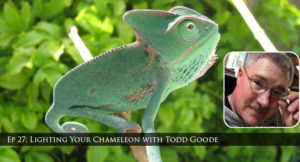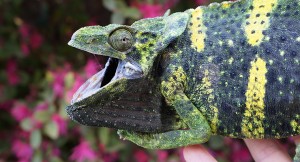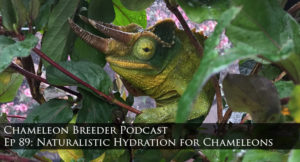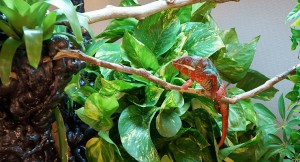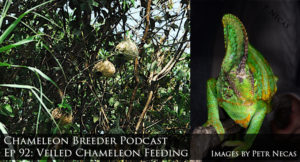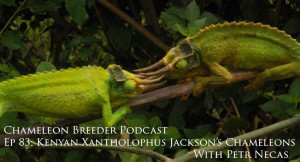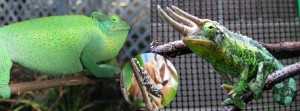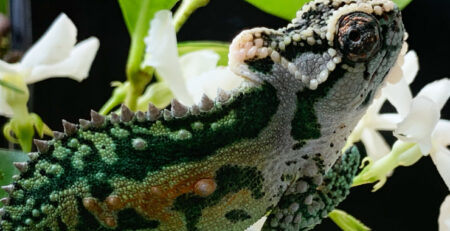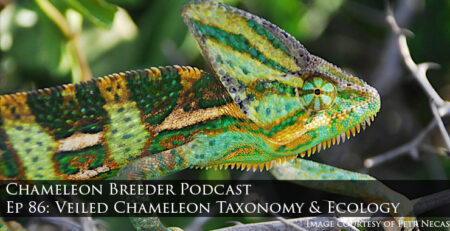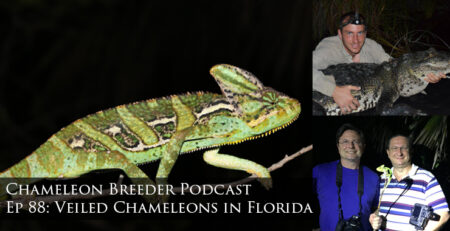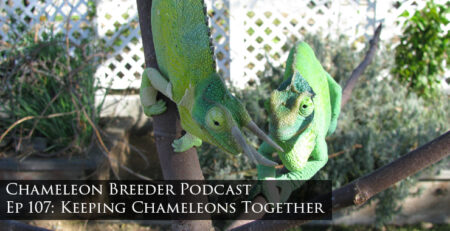Ep 99: What Chameleon Should I Get?
What Chameleon Should I Get?
Today we answer the question: What Chameleon Should I Get? This is for the keeper just starting out and finding themselves facedwith a myriad of choices. Let’s discuss your options and get you on the right track!
There is a special video made for this episode. Check it out below!
In the podcast episode I talk about a Dragon Strand Newsletter. If you are interested in caging tips and other good deals showing up in your email go ahead and sign up!
General Chameleon Research Episodes
Lighting Chameleons with Todd Goode
If you need a lighting friend, Todd Goode will be that friend. For a personalized analysis and lighting recommendation for your species/cage type call Todd at 207-588-7210. You can find his website which sells the Arcadia brand UVB bulbs at http://www.lightyourreptiles.com
Learning Chameleon Language
Hydrating Chameleons
Creating Gradients in the Chameleon Cage
UVB & MBD (two episodes recommended)
Veiled Chameleon Research
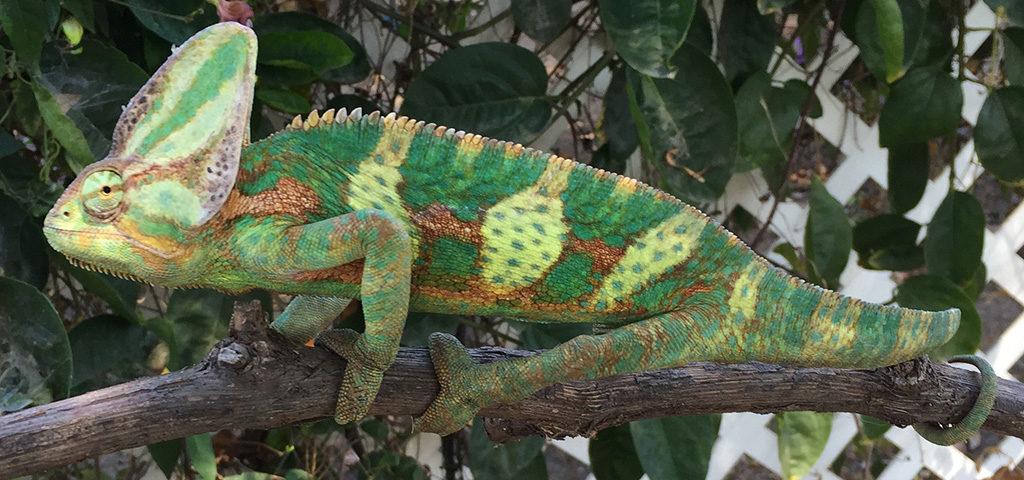
Veiled Chameleon Husbandry Part 1
Veiled Chameleon Lighting Strategies
Veiled Chameleon Feeding Strategies
Panther Chameleon Resources
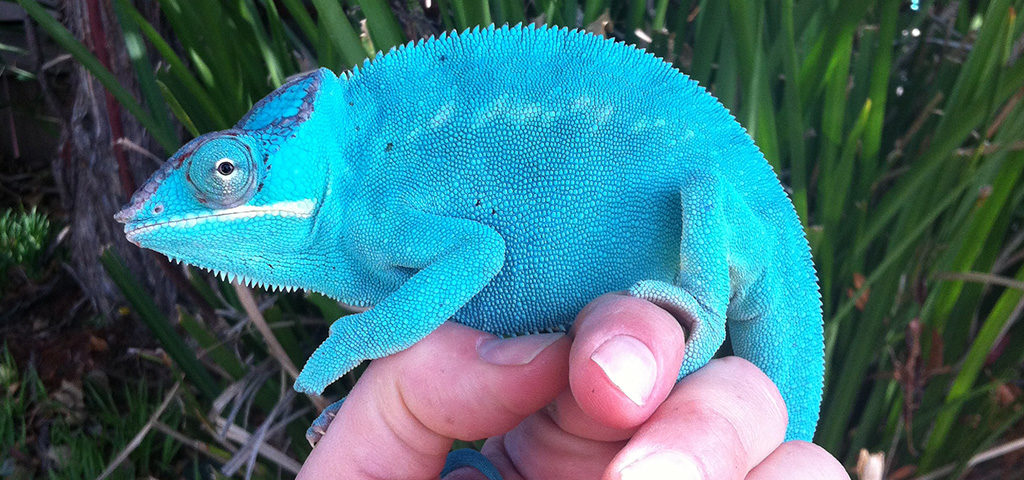
Interview with Briana Kammer of Kammerflage Kreations
Jackson’s Chameleon Resources

Naturalistic Care of the Jackson’s Chameleon
Jackson’s Chameleon General Husbandry
Kenyan Xanth Project at https://.JacksonsChameleon.org
Other Species
Carpet Chameleons

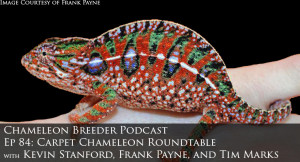
Bradypodion thamnobates
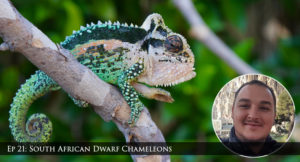
Brookesia Leaf Chameleons

Transcript of Episode (more or less)
Today we answer the question: What Chameleon Should I Get? This is for the keeper just starting out and finding themselves faced with a myriad of choices. Let’s discuss your options and get you on the right track!
The person asking which chameleon they should get is usually someone who has investigated the chameleon world enough to know that there is a whole lifetime of experiences just in chameleons! They have found out the amazing diversity of species that can be found in this chameleon world. They are, on one hand, bombarded with all the different casques, colors, horns, and spikes. On the other hand, they have been made aware that chameleons live anywhere from frigid mountain tops to the scorching desert and all the environments in-between. The question of which chameleon should I get is because sometimes it’s like walking into a candy store and sometimes it is because they are overwhelmed by the myriad of things one has to take into consideration when buying a chameleon! Are you just starting out and a little shocked at all the choices? Not sure where you should start? Well, this podcast is just for you.
Most people, when they ask the question of what chameleon they should get are talking about species. And we will definitely get to that. But I wanted to lay a groundwork of some other considerations. First of all, get a captive bred baby. There are so many healthy captive bred babies available that you have no need to deal with the challenges of a wild caught chameleon. This also gives you the advantage of being able to work with a breeder who has experience with this species and, usually, has a deep desire to help you. Now I have to warn you that there is a huge difference between the breeder of a species of a chameleon that has invested years into their animals and someone who gets a female Jackson’s Chameleon in and she has babies. Or someone who has a wild caught female lay eggs before she dies. The babies are captive born, but the person selling them may not have the experience you would expect. So once you decide on the species, add breeders to your list of what you will be researching. When you start out, having a direct line to an experienced breeder can be a lifesaver. And please do not make a decision based on the price tag. Captive bred chameleons will be more expensive. It takes at least a year and a half to ensure healthy parents, incubate eggs, and raise the babies up to sellable age. So, yes, there are expenses behind captive bred. But they are in prime condition all the way back to their parents before they existed. The cheaper price tag of the wild caughts also comes with acclimation challenges and veterinary costs. The three things you need to invest money in are the initial quality of the animal you are buying, your lighting system which includes the UVB bulb, and your supplementation. If you are working on a budget I would prefer you cut corners on anything else. I own the Dragon Strand Chameleon Caging Company. I would rather you buy a cheaper cage from someone else than to compromise on animal quality, lighting, or supplementation. Find the best of those three and then price shop/compare to your heart’s content for the rest.
I’d like to also touch on gender and age. Females are often considered less pet quality than males because they lay clutches of eggs, even infertile clutches, and the care plus nutrition that goes along with that. There is a kernel of truth to that. But female chameleons are designed to lay eggs and if you give them the proper conditions 1) they are much less likely to lay an infertile clutch and 2) if they do lay one, they will lay it and bounce back just fine. The thing is that they can be healthy chameleons only if they are given the correct husbandry. This means the proper temperatures, nutrition, and hydration. This is true for males as well! I would much rather hammer in proper husbandry than to suggest getting a male because they can handle more improper care. A properly cared for female has no issue going through the natural processes.
If you are getting a wild caught female there is a chance she is gravid and you will have the egg laying situation. If you get a live bearer, like the Jackson’s Chameleon, you run the risk of being surprised by babies even over a year after you bring her home. Yes, they store sperm and impregnate themselves when conditions are right. Conditions are usually right when the timing has them giving birth the day before you leave on your vacation. Just warning you. Just buy a captive born baby and take that stress off your plate.
Female chameleons are often more placid and can make wonderful pets. I know I will get bombarded with stories of females that were horribly ill tempered. My listenership loves to share their experiences. And I love hearing them so just keep it up! But every chameleon individual is different. So, to be able to get through any conversation about chameleons I do have to make some generalizations. Just remember you may get the one that does not listen to this podcast and does not care about fitting to the mold .
Now age…Usually adult chameleons for sale are wild caught. Please avoid these. I am telling you. Don’t fall in love with the bizarre species that the guy at the reptile show booth isn’t even sure of the scientific name. Do that kind of stuff later when you are walking in knowing more about the animals than the guy selling them. On the other hand, beware of larger business that want to move animals quickly. They may breed or have babies hatched there, but do a search on the internet and social media for feedback. We are getting more and more reports of chameleons sent out way too young, having health problems and, often dying as we all rush to help this owner save their baby. These companies are technically breeders, but they are not what I am talking about when I suggest breeders. I am talking about the ones that you can call and they will guide you through each step. I am talking about the ones that have invested in the parents of your baby and can give you the lineage going back to the WC great great grandparents. I know it is hard when you are starting off. Who are the good people? Unfortunately, in this day and age, anyone can put up an awesome looking digital store front. You really have to plug into the chameleon community and get a sense for who is good.
And one more thing. Expectations. Just to be a responsible chameleon community educator, I need to touch on your expectations for a chameleon as a pet. These little dragons have been designed to sit in a tree and not be noticed. Now, there should be immediate warning bells going off for people whose idea of a pet is a dog that can’t wait to play with you, a cat that could take or leave you but likes to sit on the book you are reading, or a hamster that doesn’t do much, but is happy to sit in your hand eating a hamster treat. Chameleons don’t like to be noticed. If you would like to make a chameleon happy then walk by his cage and pretend you didn’t see him! This is the kind of pet a chameleon makes. I know you have seen people walk around with their chameleon perched on their shoulder. I know you read about chameleons that just can’t wait to get out of their cage. Unfortunately, most of the time, these seemingly positive interactions are actually the owner misreading what the chameleon is feeling and the chameleons are actually stressed by the interaction or their cage condition. There are a relatively few individuals that appear to have no fear of humans and have no problem using us as moving trees. But to have this as an expectation will, most of the time, lead to disappointment. With chameleons, we have to expect a shy creature and care for them as such with much space and time to themselves. If you do end up with a gregarious one then you are lucky. Enjoy the interaction! But the key is to not expect it as the chances are that you will get a chameleon doing what chameleons do – try not to be seen by anything that might eat them. That would include you, oh, big and looming human ape thing.
But there is a good chance you know this! If you have done enough research to know that there are Veiled, Panther, and Jackson’s Chameleons then you have probably run across some cranky old keeper spouting off about chameleons not being cuddle toys – and have been suitably warned that you’ll have to adjust your concept of a pet to bring in a chameleon. And, yeah, more than likely that cranky old keeper was me. I get around.
So, let’s get to the differences in the species! If you are asking what type of chameleon to get the philosophical answer is: the one you want. Get the one you will be so fascinated with that you will research their particular needs and, (and this is the most important point), are willing and able to give those conditions to them. If you really want a Parson’s Chameleon and have the space then a Parson’s Chameleon is what you should get. But remember that caveat. Do you have the patience to spend the year or whatever time it takes to understand them and wait for a breeder to have a captive born one available? Make sure you do it right!
Assuming you have accepted that chameleons are more of a slice of nature in your home pet rather than an interaction pet, let’s explore the options and what you want. You want a chameleon that best matches your expectations as to what a chameleon is as a pet and one whose care conditions you can provide.
Lets address the most common question regarding choosing a chameleon species. “I want one that is friendly”.
Bottom line. 1) Each chameleon is an individual. I can give general species characteristics, but you could have that one that bucks the system. 2) 9 times out of 10, the person that says their chameleon loves them and wants to be with them is misreading the situation and is stressing their poor chameleon to death. There is no reasoning with this person because they are emotionally invested in their chameleon loving them. And here is where I burst the bubble. Love as we know it is the biological process that bonds two people together so offspring can be raised. Community bonding is a biological process for animals that get survival advantage from social groups. Chameleons are neither. They don’t even have the biological part of the brain to process love. They can tame down. They can get comfortable that you won’t eat them. They will learn who you are by sight and trust you – but not a stranger. But they will not “love” you. That is not what a chameleon is and it biologically can never be that. I am sorry anthropomorphizing pack creature. Please do not interpret your chameleon’s actions through the filter of your feelings. It just doesn’t work that way. You are going to have to learn a new language. Reference episode five of this podcast to start learning chameleon language.
So, by “friendly”, we are really looking for lack of fear. This means the ability to learn and let free food overcome millions of years of evolution that says you are dangerous. So when I go through the species profiles, I will reference this characteristic.
And now a word from heaven: For the love of all that is holy and all that is unholy, get yourself a good UVB bulb. That usually means a T5 high output linear fluorescent bulb. It could mean other bulbs types, but it does not mean that weak curly bulb you got with your chameleon kit from the pet store. UVB information podcast episodes are linked to in the show notes – of course! This is critical so look into it. If I segue into that now we will never get to the topic at hand so I implore you to get yourself a decent UVB bulb. Once again, if you are not sure of what you have get a T5 High Output linear fluorescent bulb. 6% or 12% depends on species and cage set-up. You know who knows? There’s this guy at the tip of the US in Maine named Todd Goode. He runs the lightyourreptiles.com business. You can call him up and he will go over your set-up with you and give you personalized advice as to what light you need. Link is in the show notes…and I can hear the outcry, why does this have to be so complicated? Just tell me what to get! I am sorry. As painful as it is, there are no easy answers. If someone is giving you easy answers about lighting without knowing the size cage you have or about supplements without knowing the type of lighting you have and how your perching branches are set up then you are getting convenient answers that aren’t necessarily right for your situation. This is where it is good to have friends that know to ask those questions. If you don’t already have one, call Todd. He will be your lighting friend. He knows what he is talking about!
Now…Let’s talk species! For this section I will talk about the most common species available which are the Veiled Chameleon, Panther Chameleon, and Jackson’s Chameleon. Afterwards, I will touch on other species you may run into. So, with out further ado, lets jump in.
The most common chameleon as a pet is the Veiled Chameleon –Chamaeleo calyptratus.And you’ll notice we chameleon people tend to prefer using the scientific names. This is because common names are arbitrary and sometimes two species can have the same common name. You are pretty safe with the Veiled Chameleon, but get further into the chameleon world and it gets murky. So we become very comfortable with the scientific names. Besides, isn‘t it more fun to say Trioceros deremensis instead of Usambara Giant Three Horned Chameleon? If not, too bad. Just jump into the Latin names and you’ll navigate this reptilian world much easier. Anyways, the Veiled Chameleon, or Chamaeleo calyptratus, is the most popular because it is the cheapest. It is the cheapest because they have a ton of babies and they mature quickly so it is easy to create a ton more babies. This is why you see cages full of veiled babies crawling all over each other at all these booths at the reptile show. You can tell by the tone of my voice that this isn’t my most favorite condition. But, I digress…
Veiled chameleons are full of personality. Though, I must warn you that 80% of the time, that personality is cranky. It is not that they like people less than other chameleons. They just are more likely to let you know in a dramatic way that includes threatening to bite. And they are not bluffing. But they can get used to you and hate you less if they know you consistently mean food. Of course, you will point out that person on social media that has this awesome tame veiled chameleon riding around and hanging out with people. This is possible, but very rare.
I will say though, that veiled chameleons are spectacular animals. I enjoy mine immensely. If you like the look of them and are willing to accept whatever you get as far as personality, then go for it. The one huge thing I will caution you on, though. Please do not choose a veiled chameleon because of the price. And if you do, please please please do not cut corners on their care. There is this insidious habit of ours to value whatever we buy with respect to its selling price. The fact is that veiled chameleons are just as incredible of creatures as a $1000 parson’s chameleon. The monetary value we place on them is completely independent of their value as a living creature.
So, let’s do a run down of their care. You will need at least a 24” x 24” x 48” high cage for either sex. They both get sizeable. You can use a shorter cage if you get a wider cage. And, really, for just about all chameleons, width is more useful than height. You can get a smaller cage like a 16” x 16” x 30” for a baby, but they stay babies for so little time that this is almost a waste. Many people get nervous about losing their chameleon in a 48” tall cage. You won’t. And your chameleon will do great in their adult cage from the start, but as long as you are willing to buy their adult cage by at least six months of age you go ahead and get a smaller starter cage.
And that is the thing about veiled chameleons – they grow at a breakneck speed. Please listen to the podcast series I have on veiled chameleons to get all the details. (Links in the show notes)
They will need ambient temperatures around 80 degrees with a nighttime drop to the low 70s. A basking bulb can make up for cool days. Once acclimated they are amazingly hardy with reports of them surviving frosts. And, remember, this episode is not meant to give detailed care requirements. You go find the podcast episodes that talk about that in detail. We are going to keep this high level or else we will never make it to the end before you get to work and have to continue this later.
There are two critical things to keep in mind with any chameleon, but veileds especially. 1) UVB lamp and supplementation 2) do not over feed. For feeding, they will be voracious as babies. Go ahead and feed them as much as they will eat. But once they start getting older, say about six to nine months, they will slow their growth. Excess food you give them will not fuel growth, but girth. This is the second biggest problem with veiled chameleons – obesity. The first is MBD, but you got that UVB light and the calcium supplement, right? Good. But now you need to know to cut way back to around five food items a feeding two to three times a week when they are adults or else they will pack on the grams and you will get health issues. Once again, there is a whole episode series on veiled care. Please listen to that!
But let’s do the veiled chameleon profile to see if it fits in your home environment.
Personality: spirited, but usually cranky. Taming potential is variable. Some do/some don’t. They eat without problem. In fact, their genes drive them to grow at breakneck speeds so they are enthusiastic eaters! But ease off as adults.
Space needed: at least 24” x 24” x 48” or like dimensions.
Environment needed: They can enjoy environments that humans enjoy. Ambient can be upper 70s to low 80s during the day and low 70s or below at night.
It is a fascinating creature, pretty colors, alien shape, hardy, widely available as captive bred, and the only mark down for them is their cranky nature.
Next we have the Panther Chameleon. The Panther Chameleon is, perhaps, the quintessential pet chameleon. Their colors are amazing and they are widely available as captive bred. The difference between veileds and panthers in this case is that panthers are a little harder to breed and slower to reproduce. So even though they are widely available, they still retain a higher price point. So much so that people can make some decent money from breeding panther chameleons. Certainly not an extravagant life so put aside that sudden burst of enthusiasm for now. The reason why this is great for you is that there are dedicated breeders that can help you and hand hold you through the panther lifecycle. Do not underestimate the advantage this gives you as a beginning chameleon keeper! You have many potential mentors! The reason why it is important that there is money that can be made is that you have people who can justify doing it long term. This means that you have people sticking around and gathering years of experience. And this is what you want to tap into!
Panther Chameleons come in a wide variety of colors from pure bubble gum blue to deep brick red to a rainbow of colors. They are found in a wide range across Madagascar and each area has developed its own color scheme. So you can get a panther than matches your personality!
Panther Chameleons will do well in the standard 48” cage with the exception that you can go shorter if you go wider. Females grow to a smaller size than the males so can go into a 18” x 18” x 36” cage size. I, though, use the 48” size for my female Panther Chameleons as am very happy to be able to use the extra space for my cage creation.
Their personality is usually mild. Some can be fire brands and give you the business. Some take their panther name seriously, but the majority are even tempered and are among the top chameleons that I would say could be tamed. If I was told that there was a chameleon that memorized feeding time and was sitting by his bowl waiting for you to come in and do your celestial ape duties I would guess it was a panther chameleon. Females in panther chameleons are wonderful creatures. They are only drab when compared to the males. But where else can you get a pinkish-orange chameleon? They are beautiful and make wonderful chameleon pets.
The necessary temperature is similar to the veiled chameleon. High 70 to low 80s during the day with a nighttime drip to the low 70s or 60s. So these too enjoy the temperature ranges that are common in human households. Make sure they have a basking light to warm up in the morning and you are good.
Profile recap:
Personality: General personality is mild. They can be anti-social, but usually not as fiery as the veiled chameleon. Taming potential is high. And by taming I mean calming down around you. I do not mean snuggling and fetching your paper.
Space needed: 24” x 24” x 48” or like dimensions for males. I would encourage for females as well, but females can do fine in a 18” x 18” x 36” cage.
Environment needed: They can enjoy environments that humans enjoy upper 70s to low 80s during the day and low 70s or below at night.
It is a drop dead gorgeous creature, widely available as captive bred, and has a huge network of breeder support.
The next most common chameleon in the United States, at least, is the Jackson’s Chameleon. This is the original three horned, modern day triceratops. If there was one chameleon that had everything that makes chameleons the most incredible things on earth, the Jackson’s Chameleons comes the closest to checking all the boxes. Three literal horns coming off its skull, prehensile tail, independently moving eyes, amazingly long tongue, spikes down the back, live birth of babies – holy cow! – and…the cutest, most gentle eyes I have seen on a chameleon.
The Jackson’s Chameleon’s personality is the mildest of the three top species. This is a good and bad thing. It is good because you are not likely to get bit by a Jacksons, but it is bad because so many people cannot read their subtle body language and 75% of the time someone insists their chameleon loves them it is a poor stressed out Jackson’s chameleon wishing it were somewhere else.
One drawback to the Jackson’s Chameleon is that in the United States just about all the ones offered are adults taken from a feral population in Hawaii and there are some breeding areas rumored to be on the continental US, but, regardless, they are essentially wild-caught. This means they have had the stress of being captured, held, and transported.
Captive born babies are sporadically available, but most often as a result of females having babies at the retailer’s facility. So these people selling babies may know the bare minimum of care. Add to this that Jackson’s babies seem to be more delicate. The babies should be held back by the breeder longer than the standard three months to truly be solid it seems. Many of you know that I headed up the Kenyan Xanth Project which brought in Kenyan bloodlines of the Jackson’s Chameleon. (And Xanth refers to the subspecies name of the one most commonly seen – xantholophus). Within this breeding project are some dedicated breeders who have decided that we would hold babies until they were five to six months of age before selling them. Unlike the people who had babies born in their facility and they just need to sell them off, we are breeders dedicated to this species. We have cared for the parents and have spent twice as long raising up the babies. Because it is more time intensive to breed and raise Jackson’s chameleons, fewer people will do it. But if you are interested in a Jackson’s Chameleon there truly is no better place than a dedicated breeder. Go check out the jacksonschameleon.org website which is the home of the Kenyan Xanth Project to meet the dedicated breeders. I am slowly building that section out!
I’d like to give a special mention of the females. The females are great pets, at least as far as chameleons go, but one of the most fascinating things about them has caused more panic than any one other thing in the chameleon world. Not only are they live bearing, but they retain sperm. This means that if they have ever been with a male you are in for a surprise one morning. Even if that morning is over a year or even two after you brought her home and you have never had a male. So if you are buying one of those Jackson’s Chameleons at a show from that cage with no branches and twenty sad Jackson’s Chameleons hanging on the sides, you know what is in your future.
Both the males and females will need that 24” x 24” x 48” tall cage or as before, wider if you want to go shorter. They do grow slowly so a smaller grow out cage for a baby will last you longer. But I am still that guy who gives his baby chameleons adult size cages so it is up to you.
Big, big, big warning. Do not keep a pair of Jackson’s Chameleon together. I have to say this because, as I mentioned before, Jackson’s Chameleons are much more subtle in their communication. People do not get this and interpret the lack of overt fighting as a sign they get along or even love each other. No..no…no. Please do not house Jackson’s Chameleons together or else we will be helping you, six months from now, trouble shooting why one of your chameleons is slowly failing in health. And you will be saying you have kept your chameleons together all this time without a problem and that this is something new. This pattern plays itself out time after time. Don’t do this to yourself. Even if the pet store has them in the cage together, Even if the “whoops, look at this” so-called breeder says it is no problem, it is a problem. It will be a problem. It will be a subtle problem which will quietly grow and grow and then take over with the collapsing of the submissive chameleon’s immune system. So, please, do not house Jackson’s Chameleons together. Babies you can get away with it. But males after three months and females after four or five need their own space.
The biggest challenge of Jackson’s Chameleons is going to be the temperatures. We are looking for ambient temperatures around the low to mid 70s and a definite 10 to 20 degree Fahrenheit nighttime drop. If you can’t provide this then a Jackson’s may be challenged in your environment.
Overall, I give the Jackson’s chameleon a 6 out of 10 for pet potential. Visually they have a primordial beauty and they are mild mannered. They get points taken off because they need those lower temperatures and require much experience to interpret their subtle body language.
So, if you are struggling between the incredible casque of the veiled chameleon, eye popping colors of the panther chameleon, or the primeval horns of the Jackson’s Chameleon then hopefully this gives you some information to go off of. This is not a care guide! I gave some basics, but please go to the other podcasts that speak directly about these species. I’ll link to them in the show notes. If you would like me to nudge you in one direction, I would say give into the mesmerizing colors of the panther chameleon. Not only is the personality the best blend of gregariousness and pleasant attitude, but you have a huge infrastructure of long term breeders that can offer great advice and help you along. And that is just as much a secret to success as doing all your research up front!
Now if you have done research enough to find this podcast then you have been exposed to the community in some manner or function. You very well may know, or have fallen in love, with some other species. I am going to briefly touch on some other categories.
Let’s talk about the big guys. The Parson’s Chameleon, The Meller’s Chameleon, Oustalett’s Chameleon and Madagascar Spiny Chameleon. That last one is Furcifer verrucosus. Calumma parsonii, Trioceros melleri, and Furcifer oustaletti are kind of self-explanatory. These can easily outgrow the standard 24 x 24 x 48 cage. They have a certain mystique to them because they are so big. They can perch on your forearm and take up all the space. They aren’t necessarily harder to keep than other chameleons, but things have to be done on a larger scale. Personality can be exceptional and calm. But because of the size be careful wading into these waters. It does take some more dedication to their care. Make sure you are both ready for it and able to provide it. These chameleons can start out life in a standard 24x24x48” cage, but when they start getting to their adult size you need to invest in something bigger. My opinion is that to really enjoy these large chameleons, you need to be ready to make your own cage at least six feet tall and four foot wide. Remember from episode one where we talked about having to create gradients for your chameleons to move in and out of? Those gradients need to be wide spread enough that the chameleon’s body is not cold at one end and too hot at the other. And a parsonii or melleri just plain needs more space for you to create it within.
Going to the other side of the spectrum we find a number of smaller species. Here is where you will find treasure as a first time chameleon owner. Carpet Chameleons, or Furcifer lateralis, can be cared for like panther chameleons, but they are small enough to sit comfortably on your index finger. They have wild patterns and this is one of the few species where the female is more colorful than the male. There is a dedicated group of breeders in the US that can provide you with a captive hatched baby. The wild caughts are problematic and, I know you have heard this before, are a lot of trouble. When you are starting out take full advantage of the work that people have already done to establish a species! I have done two episodes on the carpet chameleon which I will link to in the show notes. This would be a great species to start with – as long as you have your basics down. They can be kept in a smaller cage. Even as small as a two foot high cage. Though you know what I am going to say – this is a great chance to have a 48” tall cage make a leaf filled forest and have your carpet chameleon have all sorts of areas to live its life! But, you can have them in smaller cages and if you are in an apartment this may be the ticket! I do have to say that they are skittish – especially the males.
There are some live bearers that are about the same size as carpet chameleons that come from South Africa. These are the Bradypodion thamnobates. The common name is the Natal lands Dwarf Chameleon, but if you try to use that no one will know what you are talking about. We just call them thamnobates. These little guys are wonderful and only available as captive bred. They are hardy and, although they are aren’t what I would call friendly, they are not skittish.
If you want to go even further down the size spectrum, we have the pygmy or leaf chameleons within the genuses Brookesia, Rhampholeon, and Rieppeleon. These chameleons break the mold and have different care requirements than the standard chameleons. You can start with these chameleons and should be able to have a good experience. There is care information available including a podcast episode on the Brookesia leaf chameleons from Madagascar.
Finally, be careful in picking up chameleons that are exotic. These are most often wild caught, and should be considered off-limits. They will provide challenges that just isn’t worth it right now. Don’t worry, once you get your chameleon legs under you you can get yourself that Calumma oshaughnessyi. But for now, limit your search to the species you can get a captive hatch or born baby. Research the breeders of that species. Call them. Email them. Find a breeder that communicates in the way that you need. This is important. We are building up your support team here! Hang out on a couple of Facebook groups. See if there is a group specifically for your species of interest. Go through the podcast archives and see if there are episodes on your species. But more than just the species, just general chameleon keeping is immensely complicated. This is podcast 99 and I have most of next year already planned. There is a lotto our art and science! So while you are researching and getting a feel for the breeders go back to episode one of this podcast and slowly work your way forward. Just the act of listening to it while you go to work each day you will immerse yourself in the community knowledge. All of this goes towards giving you the foundation to be successful.
So, did I shine a light on the situation or did I totally confuse the situation? When you ask that question “What chameleon should I get”, You really aren’t looking for someone to tell you which chameleon to get. You are looking for opinions as to what they would get and you will try it on for size until you find the one that fits. And that is what your continued study and research will give you. The more you research the more clear the decision will be.
I chose the panther chameleon as the best first chameleon because it is the perfect blend of personality, color, and a strong breeder support system. Off all those things I venture to guess that you will find an affinity for a species when you find a group of breeders that you like and respect. So, by hanging out in the community you will find yourself draw to a certain species. And if you have a firm grasp of the chameleon keeping basics, you’ll be able to transfer that knowledge to just about any species you select.
I had it a little easier when I started. I had one chameleon species to choose from – the Jackson’s Chameleon. Now there are so many more choices it is no wonder people’s head spin when trying to make a decision! But the greatest thing about the age we live in is that the information is there to be plucked off the internet. Granted, the challenge now is sifting through the garbage and plucking the right information out, but you are on your way to getting information straight from the mouths of the experienced people. This podcast is a good place to start.
So, go into that chameleon world and soak up all that information. I advise not to rush into anything. There are so many incredible species and things constantly pop up. Do not rush into buying a chameleon if you are not ready because you think this is the only time you will get the opportunity. Relax..you will have such a good experience if you set up the cage first, make sure the misting system is going, the lights are working and the live plants are settling in before your chameleon comes home. Of course, it is good to know the species so you can plan for that, but usually adjustment between species are easily adjusted temperature differences. You are on the right path and if you are researching before getting your chameleon you are doing it the most relaxed and thorough way possible! Good job!
Now a little bit about me. Many of you know that I run the Dragon Strand Chameleon Caging company. I don’t always mention it much here, but it is what pays for everything that it takes to produce and keep this podcast on the air. We are the only chameleon caging company that actually keeps chameleons. That is why the cages are built the way they are and have the quality they do. It’s because I use them every day and use them a lot! So, this is the favor I ask of you. I’d like to invite you to join a bi-weekly newsletter for the Dragon Strand caging company that I started. It originally was just a shipping schedule update, but has grown to include caging hints and tips, questions and answers and even promotions from other companies in the industry. We actually have a nice one going right now with Full Throttle Feeders on their feeder cups. If you are listening to this in the future then just hang tight as there will be others. In the past we have had instructions for building your own feeder run or outdoors planter box cage. We’ve talked about best ways to clean the cage and how to use Dragon Ledges. So, if getting that kind of information delivered to you sounds like a fine idea, go to the DragonStrand.com website and find the Newsletter tab. It is self-explanatory from there. Or, of course, go to the show notes where a link to the newsletter sign up will be amongst a sea of other links to help you make that “what chameleon should I get decision”! Thank you for joining me here for episode 99 of the Chameleon Breeder Podcast. And, yes, we are going to have some fun for episode 100. I’ll see you then!



